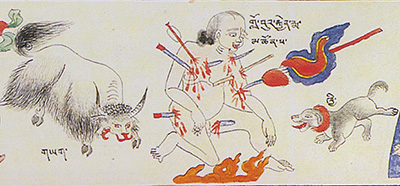Tibetan: གློ་བུར་རྨ། གློ་བུར་རྐྱེན་གྱི་རྨ།
Pronunciation: loboor ma/ loboor changy ma
Wylie: glo bur rma/ glo bur rkyen gyi rma
Lit.: «sudden injury»

Wounds
An injury to the body which breaks through the skin to reveal the underlying tissue caused by an external action.
Different types of wound and their treatment are detailed in chapters 82-86 of the Oral Instructions Tantra (the third of the Four Tantras of Gyu Shi).
Gyu Shi describes eight types of wound:
- Superficial (བཤུས་པ་ Wyl: bshus pa) – a laceration which tears only the skin, bleeds and oozes chuser with a temporary burning sensation.
- Longitudinal (གཤགས་པ་ Wyl: gshags pa) – рассечения вдоль мышечных волокон.
- Transverse (བཅད་པ་ Wyl: bcad pa) – a dissection along muscle fibres.
- Deep (རྣམ་པར་བཅད་པ་ Wyl: rnam par bcad pa) – an injury that penetrates to the bone.
- Partial amputation (འཕྱང་བ་ Wyl: ‘phyang ba) – a sharp-force trauma of muscle and bone resulting in the partial severing of a limb or body part.
- Full amputation (ལྷུང་བ་ Wyl: lhung ba) – the complete traumatic severing of a limb or body part.
- Fracture (གྲུམས་པ་ или གྲུགས་པ་ Wyl: grums pa или grugs pa) – the bone is broken usually with extensive injury to bone, bone marrow and surrounding tissue.
- Puncture (ཕུག་པ་ Wyl: phug pa) – a wound caused by the body being pierced by a sharp pointed object or weapon.
- བོད་ལུགས་གསོ་རིག་ཚིག་མཛོད་ཆེན་མོ། Pecin, 2006, pp. 1054, ill ISBN 7-105-07607-0 (Tibetan) Comprehensive modern dictionary of Tibetan Medicine terminology.
- དུས་རབས་༢༡་པའི་བོད་ལུགས་གསོ་རིག་དངོས་ཚན་སློབ་གསོའི་འཆར་འགོད་སློབ་དེབ། , 2004 (Tibetan) Series of modern Sowa Rigpa books based on commentaries of Four Tantras (rGyud bzhi).

